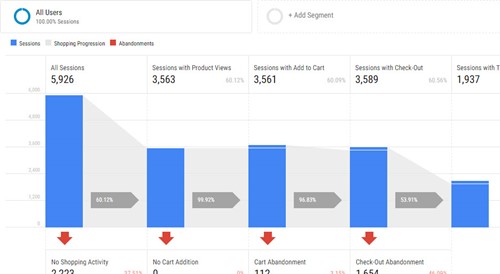There’s a wealth of data available to you to help with your Conversion Rate Optimization campaign. For instance, make sure you are using:
Using the above data points will help you better understand the pitfalls in your conversion funnel and what obstacles are preventing your users from taking action on your website. By focusing your time and effort on what the data is telling you, you have a substantially better chance of being successful in your Conversion Rate Optimization campaigns. Remember, your most important tool in Conversion Rate Optimization campaign toolbox is your data.
Best Practices Aren’t Always Best
Don’t get me wrong, best practices are a wonderful thing - they give us structure, guidance, and are usually tested or proven. The issue with best practices is that they usually aren’t one size fits all. What I mean by this, multiple portions of your digital marketing campaign are unique:
- Your business
- Your goals
- Your audience
- Your audience’s goals
- Your industry
- Your products / services
It’s important to remember that while best practices can be a great source of inspiration in your Conversion Rate Optimization campaign, you should always use your own data to guide your hypothesis and testing schedules. Make sure that your are regularly meeting with your team to discuss your findings in your data, the hypothesis you want to test, your testing schedule, and the results that you hope to get from CRO.
If you want to test best practices that you have read about or have interest in, make sure that they align with your target audience’s goals. If they do not align with your target audience’s goals, then they are not worth your time and you should consider them irrelevant to your campaign. You’ll be able to find this by:
The above data sources under “Always Follow the Data” above will help you.
Have a question about CRO or want our experts to conduct a CRO audit? We would love to!
It’s More Than Button Or Image Changes
Most brands who are just starting out with Conversion Rate Optimization often assume that it involves simply changing the colors of buttons or moving images. While that is partially true and can be a part of your campaign, Conversion Rate Optimization is a far more comprehensive and long term marketing solution. With Conversion Rate Optimization, you can test:
- Layouts
- Content
- Media
- Marketing channels
- Landing pages
- Redesigns
Not only are you able to test the above elements to increase conversions, but sometimes, conversions aren’t the most important thing you want to test. You can test ideas to:
- Lower your site speed
- Lower your bounce rate
- Increase your time on site
- Increase how often users visit your site
- Increase traffic from different sources or advertisements
These items above, while not a direct effect on conversions themselves, are all important to the experience that a user has on your website. For instance, if a site is slow, unfulfilling in content or copy, or feels mislead in their expectations in coming to your website, chances are your conversions will suffer because of these issues.
Don’t simply focus on your conversion rate. Pay attention to your data and see if there are other issues on your website besides users not converting. Dig a little deeper, read between the lines. When you remove the blinders of simply increasing your conversion rate, you may find other issues on your website that are hindering your website performance. Your website is an experience, and you want your user’s experience with your website to be nothing short of awesome so they will take action on your website.
There Is No Failure
A few common reasons that we have seen companies give up on CRO are because:
- They don’t see ROI out of the gate
- They don’t know how to interpret the data
- They don’t know how to prioritize tests
- They don’t have a champion to run CRO
These reasons are often viewed as “failure” for CRO, but truthfully, all of these reasons can be avoided with careful planning before you begin your CRO campaign. All of the above are simply “issues” and be easily overcome when analyzed correctly.



Conversion Rate Optimization
About the author
Dan Kipp
Dan Kipp is the Google Analytics and Google Tag Manager guru at Marcel Digital. He loves traveling, cooking, sports, and spending spare time with friends and family.